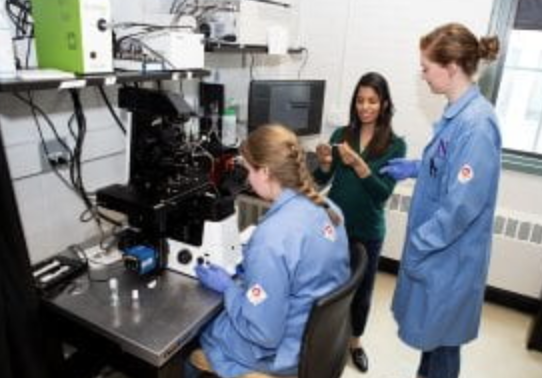Cell Maker
 Josh Leonard remembers the recruitment event where he met Neha Kamat. He already knew about her work on artificial cells, most notably as a NASA Postdoctoral Fellow at Jack Szostak’s lab at Harvard.
Josh Leonard remembers the recruitment event where he met Neha Kamat. He already knew about her work on artificial cells, most notably as a NASA Postdoctoral Fellow at Jack Szostak’s lab at Harvard.
“Neha’s accomplishments coming into this position were already extremely impressive,” says Leonard, the director of the biotechnology training program at the Center for Synthetic Biology and an associate professor of chemical and biological engineering.
Then came the interview. Leonard recalls his silence as Kamat presented her work, the energy and passion she exuded as she explained how synthetic cell membranes could be used as biosensors or someday deliver drug protocols. “The work is very compelling, but more than that was the way Neha presented it,” Leonard says. “You immediately start thinking about new ideas you want to pursue. I think all of us who met with Neha had a similar impression.”
It’s how many describe Kamat, an assistant professor of biomedical engineering at McCormick and member of the Center for Synthetic Biology since December 2017. They use words like “creative” and “dynamic” and talk about her ability to enhance any collaboration. They talk about the implications of her work, which focuses on creating artificial cells that can mimic cellular behavior. Her current research into how cell membranes respond to different types of energy won her the 2019 Young Investigator Research Program Award from the US Air Force Office of Scientific Research.
But Kamat? She says she’s the lucky one.
“I ended up at my dream school,” she says. “I knew this was a space I wanted to move into to pursue really creative ideas. You have to work with people who know the other components a lot better than you and interact with them daily to come up with ‘wacky’ new ideas.”
But Kamat’s path to Northwestern wasn’t a straight one. She grew up the daughter of a Notre Dame professor and software developer in South Bend, Indiana. Hoping not to run into them on campus, Kamat studied bioengineering at Rice University in Houston under Jennifer West, a noted biomaterials and nanotech researcher. “That's where my love of research began,” she says.
But it was at the University of Pennsylvania with Daniel Hammer where she discovered her love for artificial cells. It came the first time she made a cell membrane out of synthetic polymers. She looked at them under the microscope and was amazed.
“I saw these perfect circles dancing around and it was beautiful,” she recalls “I thought ‘Well, this is something I could stare at for a long time.’”
Kamat tempers that zeal with a similar passion for engineering. “Cells already perform such complex functions,” she says. “By trying to reconstruct them, we can learn how they work and put the parts back together in new ways.”
Kamat finished her doctorate in 2012 but still felt she had gaps in her knowledge. While she understood how to build cell membranes, she wondered if they could interact with their environments and make decisions, much like cells do. “Something you learn as a scientist is to identify the gap in your knowledge bank that you need to seal to do what you actually want to do,” she says.
That led her to the postdoctoral program at Harvard University and Szostak, who won the 2009 Nobel Prize as part the team that discovered telomeres, the caps on the end of DNA strands that prevent cellular decay. His lab at Massachusetts General was working on genetic polymers that could rewire parts of a cell. “I thought, ‘That's the field I need to move into,’” she says.
Kamat spent four years in Boston studying RNA, a crucial polymer in forming cellular life, and using membranes to study how the two components may have worked together to form primitive cells. Her studies on how RNA behaves inside membranes — led to her eventual arrival in Evanston and quest to build synthetic cells.
Since joining the Center for Synthetic Biology, she’s started several projects, including one funded by a National Science Foundation grant with Leonard to graft biological sensors onto synthetic cells. A second project with Danielle Tullman-Ercek, who runs the master’s biotech program, is looking into the role of micro-compartmentalization in biochemical systems.
“She has this vision that she can implement extremely quickly, says Tullamn-Ercek, an associate professor in chemical and biological engineering. “We tend to come up with something creative and if that doesn't pan out, we come up with something else creative, but there's already a path for it. She's able to pivot and come up with a new direction on the spot.”
While she enjoys working and collaborating with her colleagues, Kamat knows she’s still near the beginning of a lifelong journey to understanding cell membranes — from how they form to how they respond to environmental signals— to the point where she can reverse-engineer
them synthetically for different applications.
“This basic question of how cell membranes work will lead to the development of sensors and drug delivery tools,” she says, “but right now I’m focused on the fundamental question of how the lipids and proteins work together to accomplish specific tasks.”
By Glenn Jeffers